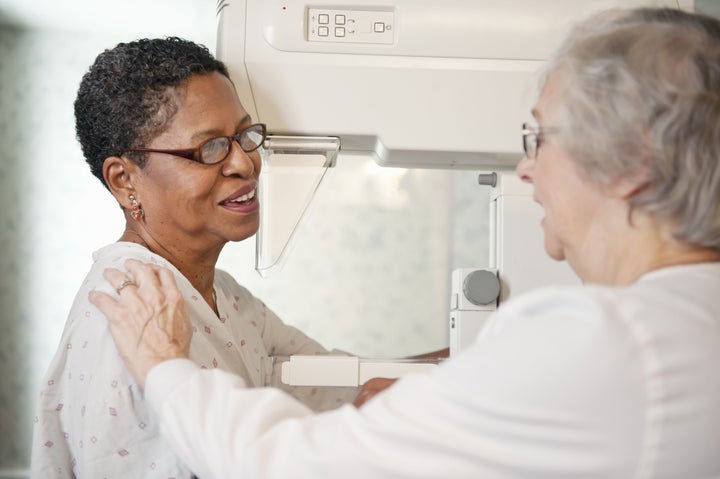
When should you consider getting screened for breast cancer?
The answer depends on who you ask. New breast cancer screening guidelines from the U.S. Preventive Services Task Force, a government-convened committee of independent medical experts, say the research is clear: Women between the ages of 50 and 74 should have a mammogram at least every other year. For everyone else, it depends.
Women in their 40s could start considering biennial mammograms, according to the task force, but doing it this young increases the risk of potential downsides that come from screening, including false positives. For women over the age of 75, the data is inconclusive. And for women with higher than average risk, like those with a past history of breast cancer or a family history of breast cancer, the new recommendations don't really apply at all -- they should factor their risk into their decision to screen and perhaps come up with an alternative and more aggressive schedule for themselves with the doctor’s help.
These latest guidelines come less than three months after the American Cancer Society released their own updated recommendations that women should get their first screening no later than age 45 and should begin biennial screening from 55 years onward.
Taken together, the organizations' guidelines form the two leading voices on breast cancer screenings in the United States and indicate a major shift away from annual screenings for middle-aged women with average risk. And they also fall in line with long-standing European health officials’ recommendations that women ages 50 to 69 should get screened every two years.
These guidelines won't affect insurance coverage
The task force's previous update on mammography guidelines, written in 2009, was the first time they recommended against routine mammograms for average-risk women in their 40s. The 2009 guidelines also dropped their previous recommendation for annual screening in favor of biennial screening for women aged 50 to 74.
This caused outrage: The American Cancer Society spoke out against the report, and Congress added a provision to the Affordable Care Act to ensure yearly mammograms would remain covered and free for all women, virtually disregarding the presented guidelines.
To ensure continued coverage for annual screenings, last month President Barack Obama once again signed a law ensuring full coverage for mammography in women 40 and older through 2017.
That means these latest 2016 recommendations will have no effect on insurance coverage for mammographies. In a blog post timed to the release of the USPSTF’s new guidelines, Dr. Nancy C. Lee of the U.S. Department of Health and Human Services emphasized, “If a woman 40 years and older and her doctor determine that a mammogram is appropriate, she will not have to pay out of pocket."
Critics respond: Mammograms save lives
Dr. Elisa Port, chief of breast surgery at Mount Sinai Hospital in New York City, slammed the recommendations and said they were confusing and “all over the map” when compared to past guidelines.
"The bottom line is that we have clearcut data that shows death from breast cancer is reduced for women between the ages of 40 and 70 with yearly mammograms,” said Port to HuffPost. “Why anyone would recommend mammograms every other year in women in the 50 and older age group is beyond me."
Port also said that the higher risk of complications that come from a false-positive diagnosis are overblown, and that in most cases amount to nothing more than taking a few more pictures with the mammogram.
"While it can be stressful and can lead to anxiety, I think most women would agree it’s a relatively small price to pay for picking up cancer earlier,” she concluded.
But according to Dr. Albert Siu, chair of the task force, it's more than just anxiety that's at stake: Compared to women screened biennially, annual screening is expected to save the lives of one to two additional women for every 1,000 women. But it also results in an additional 80 to 125 biopsies and six to nine over-diagnoses in women. These over-diagnoses then result in over-treatment, which can include surgery, chemotherapy and radiation.
"In other words, [they’re] diagnosed and treated for a cancer that would have never caused health problems or even become apparent without screening,” Siu said.
"The task force believes all women deserve to understand what the science says about both the potential benefits and harms of breast cancer screening—so they are empowered to make the best choice for themselves, together with their doctor,” Siu added. "The science shows that screening is most beneficial for women ages 50 to 74."
Next step: Talk to your doctors

While the different guidelines might be confusing to women who just want to know when they should start getting mammograms, Electra Paskett, a cancer control researcher at The Ohio State University Comprehensive Cancer Center, said that the different organizations' guidelines don’t actually contradict each other.
Paskett, who wasn’t involved in the guidelines but does support them, says that the overarching message for women is that they need to talk to their doctors about when to start screening, how often to screen and when to stop, based on that individual person’s specific risk factors, medical history and their anxiety levels. In addition to the benefits of screening, the doctors should also discuss the potential harms that can come from screening, like false positives that can lead to more mammograms, ultrasounds, MRIs and biopsies -- procedures that can make women feel anxious and carry a small risk of side effects.
"Mammography is a very important tool that we have for fighting cancer, and it’s important that anyone considering any type of screening test should be doing it in an informed manner, and have a discussion with their healthcare provider about the test: why it’s being done, what the results mean, and what the best test is for them,” said Paskett. "Unfortunately that doesn't happen all the time, but we need to move toward that."
CORRECTION: A previous version of this story incorrectly used the word "biannual," which means twice a year, when we meant "biennial," or every other year. We regret the error.
Also on HuffPost:


